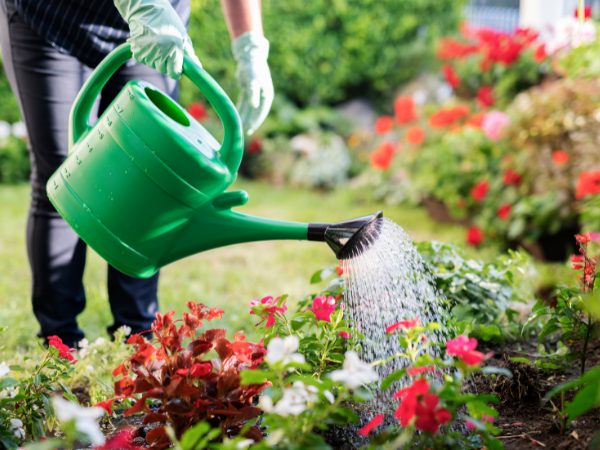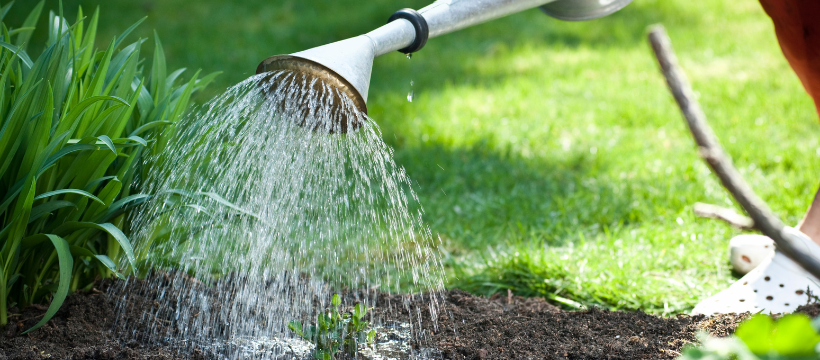
Watering Tips for Hot Weather
Nurturing Your Garden: Watering Tips for Preparing Plants for Hot Weather & Signs of Heat Stress
As the temperatures rise and summer approaches, ensuring that your garden is adequately hydrated becomes paramount. Proper watering techniques are essential to help your plants thrive during hot weather conditions. One such technique is deep watering, which involves providing water to the roots rather than just the surface of the soil. In this blog, we will explore the importance of deep watering and provide valuable insights into how you can best water your garden to prepare your plants for the scorching days ahead.
Understanding Deep Watering: Deep watering is a watering technique that focuses on saturating the soil to a sufficient depth, allowing the roots to access the water they need. When watered deeply, plant roots are encouraged to grow deeper into the soil in search of moisture, making them more resilient and better equipped to withstand hot weather conditions. Shallow watering, on the other hand, only moistens the surface soil, leading to shallow root growth and increased vulnerability to heat stress.
Key Strategies for Effective Watering:
1. Watering Schedule:
Establishing a consistent watering schedule is crucial for plant health, especially during hot weather. Early morning or late afternoon is generally the best time to water, as these periods minimize water loss due to evaporation. Avoid watering during the hottest part of the day, as the water droplets can act as magnifying glasses, intensifying the sun’s rays and potentially scorching the foliage.
2. Amount of Water:
To promote deep root growth, it aims to deliver a sufficient amount of water that reaches at least 6 inches into the soil. This depth can vary depending on the plant’s size and water requirements. Avoid overwatering, which can lead to root rot and other fungal diseases. The goal is to moisten the soil thoroughly without creating waterlogged conditions.
3. Watering Techniques:
Utilize techniques that facilitate deep watering. One effective method is using a soaker hose or drip irrigation system. These systems deliver water directly to the base of the plants, allowing it to seep into the soil and reach the roots slowly. This approach minimizes water wastage and encourages deeper root growth.
4. Mulching:
Applying a layer of organic mulch, such as wood chips or straw, around your plants helps conserve soil moisture by reducing evaporation. Mulch also acts as an insulating barrier, keeping the soil temperature stable and protecting the roots from extreme heat. Remember to leave a small gap between the stem or trunk and the mulch to prevent moisture-related issues.
5. Monitoring Soil Moisture:
Regularly check the moisture level of the soil to determine if watering is required. Stick your finger or a small garden tool about 2-3 inches into the soil. If it feels dry at that depth, it’s an indication that watering is needed. Utilizing moisture meters or installing soil moisture sensors can also provide accurate readings.
Watering your garden deeply is a vital practice when preparing your plants for hot weather. By adopting these strategies, you can ensure your plants have access to the water they need to thrive and remain resilient during scorching temperatures. Remember to establish a consistent watering schedule, deliver an adequate amount of water, employ efficient watering techniques, utilize mulch for moisture retention, and monitor soil moisture levels. With these practices in place, your garden will flourish and provide a refreshing oasis even on the hottest of days.

Other Tips for Combating the Heat
Provide Shade
One of the most effective ways to protect your plants from heat stress is to provide shade during the hottest parts of the day. You can use shade cloths, garden umbrellas, or even strategically place larger plants to create natural shade. This will help reduce the direct exposure to intense sunlight and lower the temperature around your plants, preventing leaf scorch and wilting.
Avoid Pruning
During extreme heat, it’s best to avoid pruning your plants. Pruning can cause additional stress by removing foliage that helps shade the plant and retain moisture. Instead, wait until cooler weather returns to do any necessary trimming. Keeping the plant as intact as possible during hot spells allows it to withstand the heat better and recover more effectively.
Feeding Frenzy
Providing your plants with extra nutrients can help them combat the stress of high temperatures. Use a balanced, water-soluble fertilizer to give your plants a boost, focusing on potassium-rich formulas that enhance their ability to manage stress. Additionally, consider incorporating organic compost or mulch around the base of your plants to improve soil moisture retention and provide a slow-release source of nutrients.
Plant Drought Tolerant Plants
Another effective way to manage heat stress in your garden is by planting drought-tolerant perennials. These resilient plants are designed to withstand dry conditions and require less water, making them perfect for hot weather. Incorporating drought-tolerant plants into your garden not only reduces your watering needs but also ensures that your landscape remains vibrant and colourful even during dry spells.
Consider adding perennials such as Sedum, Echinacea, Lavender, Agastache, Gaillardia, Salvia, Perovskia, Nepeta, Achillea, and Rudbeckia. These plants thrive in hot, dry conditions and provide beautiful blooms throughout the growing season. By choosing these hardy varieties, you can create a garden that is both water-efficient and visually appealing.
For more information on drought-tolerant plants and how to incorporate them into your garden, click here.

Signs of Heat Stress in Your Garden:
As the summer sun shines brightly, our beloved garden plants might show signs of heat stress. But don’t worry, they’re not dead! Here are some signs to watch for and tips to help them thrive again:
- Wilting: Leaves drooping or looking lifeless during the hottest parts of the day.
- Scorched Leaves: Brown, crispy edges or spots on leaves.
- Leaf Drop: Plants might shed leaves to conserve water.
- Discoloration: Yellowing or pale leaves indicating a lack of moisture.

 Do Not Dig Up Your Plants!
Do Not Dig Up Your Plants! 
Heat-stressed plants are not dead. Digging them up can cause more harm than good. With a bit of TLC, they’ll bounce back and continue to flourish. Remember, a little extra care goes a long way. Keep an eye on your garden, and let’s help our plants beat the heat!
